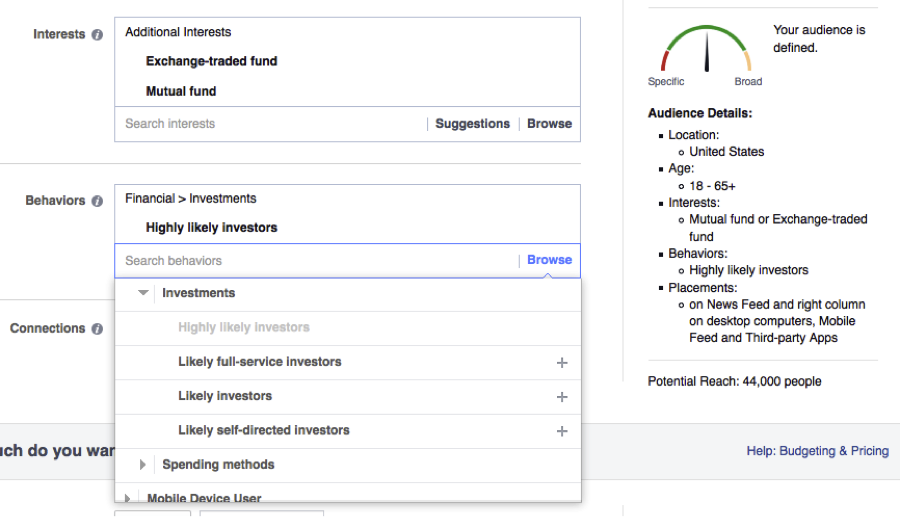New Developments in Advanced Facebook Targeting
New Developments in Advanced Facebook Targeting
While Facebook has traditionally lagged behind Google in advertising performance, we’ve always known there was huge potential in Facebook Advertising for our clients. One in 7 people worldwide and over 50% of the U.S. population has a Facebook profile. Half of users log on every single day. In fact, the advertising reach on Facebook is now approaching the reach of Cable Television in the U.S. Even more important, Facebook’s targeting capabilities are far more advanced than Cable TV. Think about it-Facebook knows your likes, your behavior, and even the keywords in your posts.
This year Facebook has become a serious conversion and sales driving ad platform for our clients. In addition to the increased effectiveness of being able to advertise in consumers’ newsfeeds with sponsored “dark” posts which are now getting us more conversions on Facebook than Google for some clients. Facebook has made huge leaps in their targeting capabilities.
Here’s what’s exciting about the advancements in Facebook targeting: We’ve traditionally only been able to target Facebook users by “interest.” For example if a user has “liked” a competitor’s page or liked the page of a co-linear brand, or perhaps keywords in a user’s Facebook profile. Now, in addition to simply targeting by interest, we can target based on a client’s off-Facebook behavior. This allows us to offer targeting abilities on Facebook ads that we could only achieve previously with sophisticated (and expensive) ad servers.
Facebook has partnered with data providers including Acxiom, Epsilon, Datalogix, and BlueKai to create thousands of predefined targeting categories. Facebook is able to overlay this 3rd party behavior data with Facebook’s own user data. These new targeting categories allow us to target Facebook users based on their actual browsing and purchase behavior on other websites outside of Facebook and even in the offline world.
We can access these new predefined targets in a new “behaviors” box in the ad interface. This box of targeting options is separate from the “interests” box to which we’ve always had access.

Here’s an example of how a financial services client selling mutual funds has traditionally targeted via “interests” on Facebook:

In this case, we’ve created a large test cell, using the traditional “interests” of Exchange Traded Fund and Mutual Fund. This has an audience of 840,000 people.
Using the “behaviors” box, we now can target different behavioral profiles of investors, for example, Acxiom’s Highly Likely Investors behavior includes 10.4 million people.

“That’s great,” you might say sarcastically, we now have another, likely much broader and poorer performing test cell to test.
No– What’s exciting about this is that we can now target simultaneously by both behavior and interest. For example, if we choose the original test segments of Exchange Traded Fund and Mutual Fund in “Interests” and also choose Highly Likely Investors in “Behaviors,” we get a potentially high-performing, tight segment of just 44,000 possible customers.

Without giving away too much proprietary information: A small, tight segment is the key to overcoming Facebook ad platform’s propensity to maximize reach, while ignoring frequency.
In essence, the new behavioral targeting capabilities of Facebook, certainly give us more targeting options to test, but even more importantly, they allow us the unprecedented ability to do Boolean targeting with Target A AND Target B. What this means is that we can use different combinations of both behavior and interest targets to develop a much more precise and focused set of test cells. More precise and focused test cells mean we have better performance. What’s interesting is that better performance comes not just by being more relevant to the target, but by the unintended side benefit of smaller test cells that max out on reach sooner and give us the ability to truly manage ad frequency in a more effective way than ever before possible.
In fact, we wonder if Facebook foresaw this or if it’s a huge, unintended benefit. Either way, new behavioral targeting options are not only giving us more targeting choices, but they’re clearly giving us more control over ad frequency and THAT is perhaps the biggest benefit of the changes.
Facebook can actually create demand for clients, something Paid Search marketing inherently can’t do. With these new behavioral targeting options, we’re now able to drive even more revenue from Facebook ads for clients.









No Comments